List of the major 5000-meter summits of North America
The following sortable table comprises the 11 mountain peaks of greater North America[1] with at least 5000 meters (16,404 feet) of elevation and at least 500 meters (1640 feet) of topographic prominence.[2]

The summit of a mountain or hill may be measured in three principal ways:
- The topographic elevation of a summit measures the height of the summit above a geodetic sea level.[3][4]
- The topographic prominence of a summit is a measure of how high the summit rises above its surroundings.[5][4]
- The topographic isolation (or radius of dominance) of a summit measures how far the summit lies from its nearest point of equal elevation.[6]
In greater North America, only Denali exceeds 6000 meters (19,685 feet) elevation. Three major summits exceed 5500 meters (18,045 feet), the following 11 major summits exceed 5000 meters (16,404 feet), 21 exceed 4500 meters (14,764 feet), 124 exceed 4000 meters (13,123 feet), 277 exceed 3500 meters (11,483 feet), and 401 exceed 3000 meters (9843 feet) elevation.
Major 5000-meter summits
Of the 11 major 5000-meter summits of North America, five are located in the United States, four in Canada, and three in México. Mount Saint Elias lies on the Canada-United States border and is the second highest major summit of both countries.
Gallery

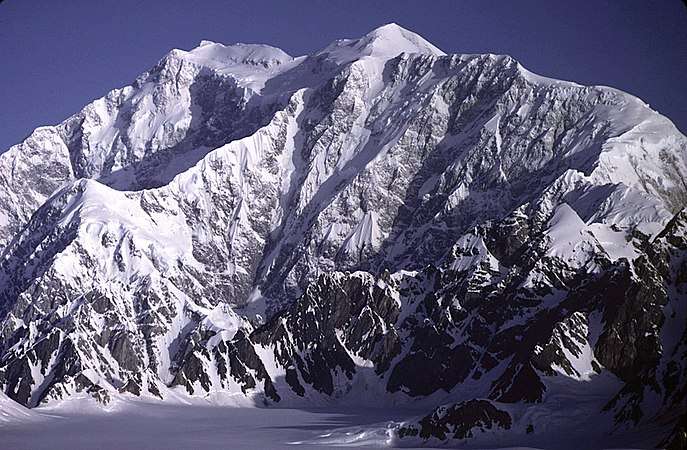
 3. Pico de Orizaba is the highest summit of México.
3. Pico de Orizaba is the highest summit of México.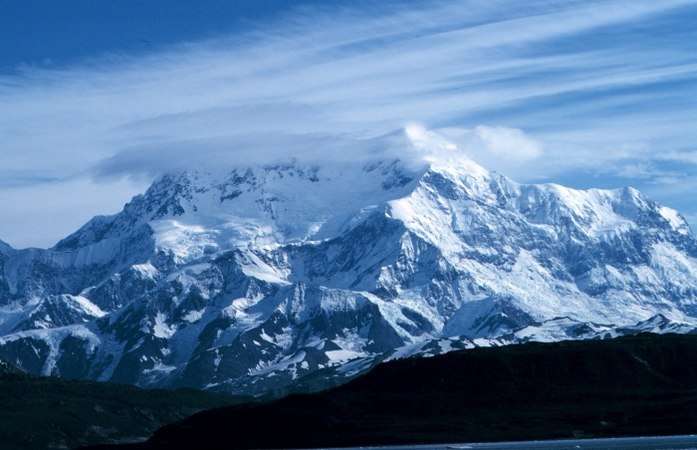
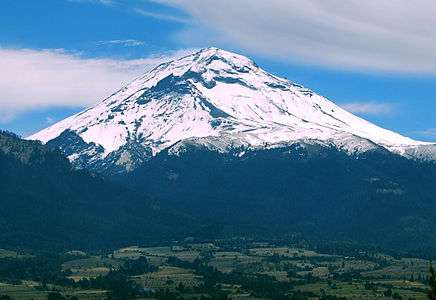 5. Popocatépetl is the second highest summit of México.
5. Popocatépetl is the second highest summit of México.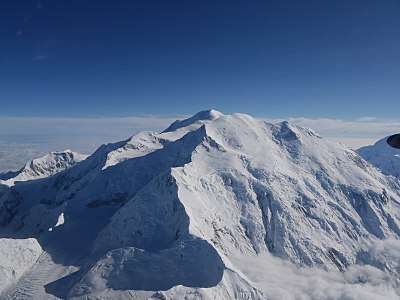 6. Mount Foraker is the second highest major summit of the Alaska Range.
6. Mount Foraker is the second highest major summit of the Alaska Range.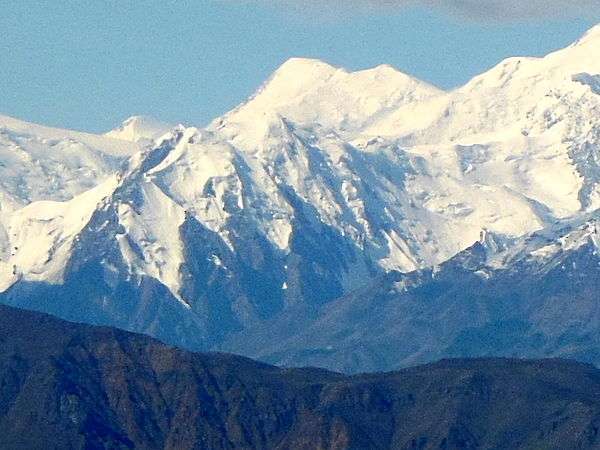
- 8. Iztaccihuatl is the third highest summit of México.
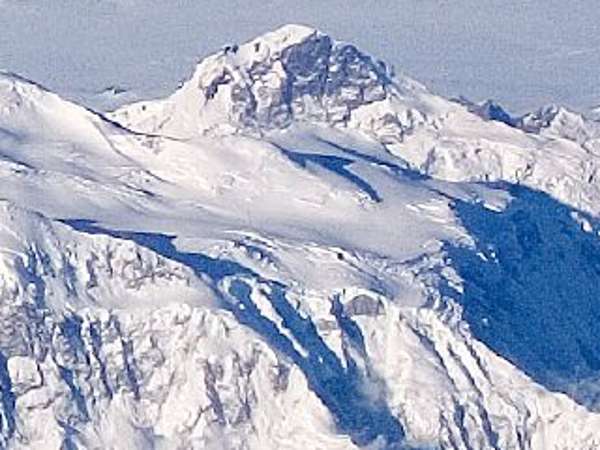
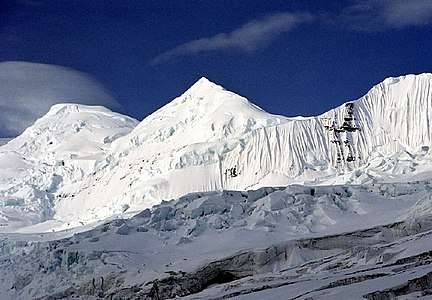

See also
- North America
- Geography of North America
- Geology of North America
- Lists of mountain peaks of North America
- List of mountain peaks of North America
- List of the highest major summits of North America
- List of the major 5000-meter summits of North America
- List of the major 4000-meter summits of North America
- List of the major 3000-meter summits of North America
- List of the highest islands of North America
- List of the most prominent summits of North America
- List of the ultra-prominent summits of North America
- List of the most isolated major summits of North America
- List of extreme summits of North America
- List of mountain peaks of Greenland
- List of mountain peaks of Canada
- List of mountain peaks of the Rocky Mountains
- List of mountain peaks of the United States
- List of mountain peaks of México
- List of mountain peaks of Central America
- List of mountain peaks of the Caribbean
- List of the highest major summits of North America
- Category:Mountains of North America
- List of mountain peaks of North America
- Physical geography
Notes
- The summit of Denali is the highest point of the Alaska Range, the State of Alaska, the United States of America, and greater North America. Denali is the third most topographically prominent and third most topographically isolated summit on Earth after Mount Everest and Aconcagua.
- The summit of Mount Logan is the highest point of the Saint Elias Mountains, Yukon, and all of Canada.
- The summit of Pico de Orizaba is the highest point of Estado Libre y Soberano de Puebla, Estado Libre y Soberano de Veracruz de Ignacio de la Llave, and all of México.
- Mount Saint Elias is the second highest major summit of both Canada and the United States.
- Popocatépetl on the border of Puebla is the highest point of both Estado Libre y Soberano de México and Estado Libre y Soberano de Morelos.
- Popocatépetl is the southernmost 5000-meter (16,404-foot) summit of México and greater North America.
- Mount Foraker is the westernmost 5000-meter (16,404-foot) summit of Alaska, the United States, and greater North America.
- The summit of Mount Lucania is the highest point of the northern Saint Elias Mountains.
- Mount Lucania is the northernmost summit of its elevation in Canada.
- Iztaccíhuatl is the northernmost and westernmost 5000-meter (16,404-foot) summit of México.
- The summit of Mount Bona is the highest point of the northwest Saint Elias Mountains.
- Mount Steele is the northernmost and easternmost 5000-meter (16,404-foot) summit of Canada.
References
- This article defines greater North America as the portion of the continental landmass of the Americas extending westward and northward from the Isthmus of Panama plus the ocean islands surrounding that landmass. This article defines the ocean islands of greater North America to include the coastal islands of North America, the islands of the Caribbean Sea, the Lucayan Archipelago, the islands of Greenland (Kalaallit Nunaat), the islands of Canada, and the islands of Alaska. The Hawaiian Islands are not included because they are considered part of Oceania.
- This article defines a significant summit as a summit with at least 100 meters (328.1 feet) of topographic prominence, and a major summit as a summit with at least 500 meters (1640 feet) of topographic prominence. All summits in this article have at least 500 meters of topographic prominence. An ultra-prominent summit is a summit with at least 1500 meters (4921 feet) of topographic prominence.
- All elevations in the 48 states of the contiguous United States include an elevation adjustment from the National Geodetic Vertical Datum of 1929 (NGVD 29) to the North American Vertical Datum of 1988 (NAVD 88). For further information, please see this United States National Geodetic Survey note.
- If the elevation or prominence of a summit is calculated as a range of values, the arithmetic mean is shown.
- The topographic prominence of a summit is the topographic elevation difference between the summit and its highest or key col to a higher summit. The summit may be near its key col or quite far away. The key col for Denali in Alaska is the Isthmus of Rivas in Nicaragua, 7642 kilometers (4749 miles) away.
- The topographic isolation of a summit is the great-circle distance to its nearest point of equal elevation.
- "Denali". Peakbagger.com. Retrieved 4 May 2016.
- "Denali". Bivouac.com. Retrieved 4 May 2016.
- "Mount Logan". Peakbagger.com. Retrieved 4 May 2016.
- "Mount Logan". Bivouac.com. Retrieved 4 May 2016.
- "Pico de Orizaba". Peakbagger.com. Retrieved 4 May 2016.
- "Pico de Orizaba". Bivouac.com. Retrieved 4 May 2016.
- "Mount Saint Elias". Peakbagger.com. Retrieved 4 May 2016.
- "Mount Saint Elias". Bivouac.com. Retrieved 4 May 2016.
- "Popocatépetl". Peakbagger.com. Retrieved 4 May 2016.
- "Popocatépetl". Bivouac.com. Retrieved 4 May 2016.
- "Mount Foraker". Peakbagger.com. Retrieved 4 May 2016.
- "Mount Foraker". Bivouac.com. Retrieved 4 May 2016.
- "Mount Lucania". Peakbagger.com. Retrieved 4 May 2016.
- "Mount Lucania". Bivouac.com. Retrieved 4 May 2016.
- "Iztaccíhuatl". Peakbagger.com. Retrieved 4 May 2016.
- "Iztaccíhuatl". Bivouac.com. Retrieved 4 May 2016.
- "King Peak". Peakbagger.com. Retrieved 4 May 2016.
- "King Peak". Bivouac.com. Retrieved 4 May 2016.
- "Mount Bona". Peakbagger.com. Retrieved 4 May 2016.
- "Mount Bona". Bivouac.com. Retrieved 4 May 2016.
- "Mount Steele". Peakbagger.com. Retrieved 4 May 2016.
- "Mount Steele". Bivouac.com. Retrieved 4 May 2016.
External links
- Natural Resources Canada (NRC)
- United States Geological Survey (USGS)
- United States National Geodetic Survey (NGS)
- Instituto Nacional de Estadística, Geografía e Informática (INEGI)
- Bivouac.com
- Peakbagger.com
- Peaklist.org
- Peakware.com
- Summitpost.org